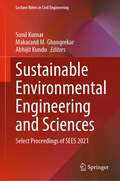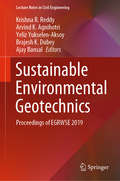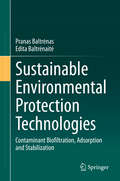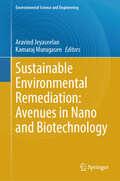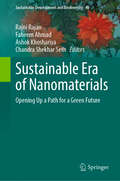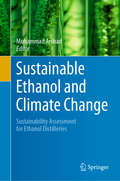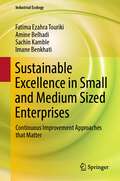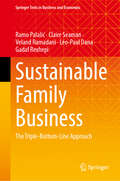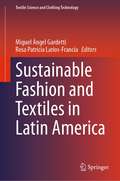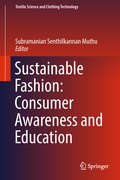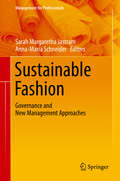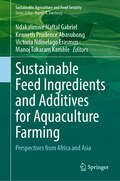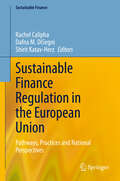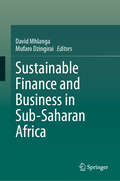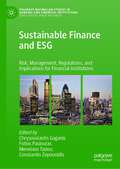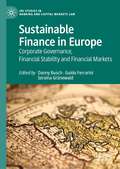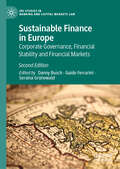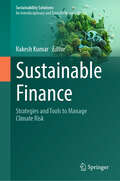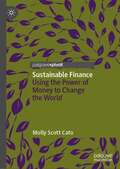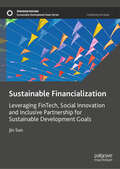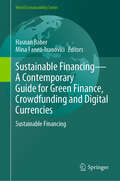- Table View
- List View
Sustainable Environmental Design in Architecture: Impacts on Health (Springer Optimization and Its Applications #56)
by Panos M. Pardalos Stamatina Th. RassiaOver the last few decades, there have been dramatic improvements in the understanding and research of environmental design. Numerous methods have been developed to enhance architectural design in order for it to be more energy efficient, sustainable and health enhancing. This book presents several theories and techniques that can be used to improve how buildings are engineered and designed in order to utilize more sustainable construction methods while promoting the health of the building's occupants. Contributions to the study of environmental design have come from a diversity of fields including applied mathematics, optimization, computer science, medical research, psychology, management science, architecture, and engineering. The techniques developed in these areas of research can be used to increase building performance, occupant satisfaction, productivity, and well being, and reducing the incidence of health conditions and chronic diseases related to the use of a designed space. This book provides architectural practitioners, civil engineers as well as other interdisciplinary researchers with the techniques needed to design, implement, and test for sustainability and health promotion in new or existing structures.
Sustainable Environmental Engineering and Sciences: Select Proceedings of SEES 2021 (Lecture Notes in Civil Engineering #323)
by Sunil Kumar Makarand M. Ghangrekar Abhijit KunduThis book presents the select proceedings of the International conference of Sustainability in Environmental Engineering and Science (SEES) 2021. It presents the latest developments in civil engineering that cover all aspects and challenges in civil engineering, environmental engineering and environmental science. Various topics covered in this book include construction and structural mechanics, building materials, concrete, steel and timber structures, geotechnical engineering, earthquake engineering, and coastal engineering. The volume will be useful for beginners, researchers, and professionals working in the areas of sustainable civil engineering and related fields.
Sustainable Environmental Geotechnics: Proceedings of EGRWSE 2019 (Lecture Notes in Civil Engineering #89)
by Krishna R. Reddy Ajay Bansal Arvind K. Agnihotri Yeliz Yukselen-Aksoy Brajesh K. DubeyThis volume contains selects papers presented during the Second International Conference on Environmental Geotechnology, Recycled Waste Materials and Sustainable Engineering, held in the University of Illinois at Chicago. It covers the recent innovations, trends, and concerns, practical challenges encountered, and the solutions adopted in geoenvironmental engineering, waste management, and sustainable engineering. This book will be useful for academics, educators, policy makers and professionals working in the field of civil engineering, chemical engineering, environmental sciences and public policy.
Sustainable Environmental Protection Technologies: Contaminant Biofiltration, Adsorption and Stabilization
by Edita Baltrėnaitė Pranas BaltrėnasThis book discusses the need for the development of sustainable environmental protection technologies to reduce the impact of environmental contaminants. Three levels of sustainable technologies are addressed. The first level involves the concept of sustainable technologies as natural technologies, or ecotechnologies, whereby contamination level is assessed based on the contamination footprint through the use of biogeochemical barriers (e.g. methods utilizing the bioaccumulation properties of plants). The second level concerns the use of sustainable natural materials, such as biochar, in environmental engineering systems, an approach that is used for analyzing the processes of adsorption and biofiltration, as well as immobilization of contaminants in soil. The third level discusses the optimal components necessary to achieve sustainability in environmental engineering systems, including system operation principles, structural solutions, and the synergies between various system components such as microorganisms. The book will be of interest to specialists of industrial enterprises engaged in environmental protection, as well as environmental system designers, stakeholders from environmental protection ministries and institutions, researchers, doctoral students and masters and bachelors of science in the field of environmental engineering.
Sustainable Environmental Remediation: Avenues in Nano and Biotechnology (Environmental Science and Engineering)
by Aravind Jeyaseelan Kamaraj MurugasenThis book concentrates on trends and recent developments in nano- and microbial agents and their usage in waste minimization and pollution mitigation through review-style chapters. Population growth and affiliated human activities harm the environment, leading to an escalating pollution crisis and necessitating the development of sustainable, green, eco-friendly technologies. Environmental research is expanding and thriving, concentrating on environmentally responsive approaches to combat xenobiotics, pollutants, and emerging contaminants discharged into the environment due to various human activities. Chemical and biological methods can facilitate using sustainable practices to reduce environmental pollutants. Alternative eco-friendly technologies involving nano- and microbial agents could be viable sources for environmental remediation.The encouraging findings of these research contributions could be incorporated into commercially available environmentally sustainable appliances. This book interests scientists, academics, and scholars seeking inspiration and direction for researching sustainable environmental applications.
Sustainable Era of Nanomaterials: Opening Up a Path for a Green Future (Sustainable Development and Biodiversity #40)
by Faheem Ahmad Chandra Shekhar Seth Rajni Rajan Ashok KhoshariyaThis contributed volume provides an overview of the current status of sustainable nanomaterials and their potential applications in various industries, including agriculture. The book describes the principles of green chemistry and toxicology that are essential for the sustainable development of nanomaterials. There is a growing interest in developing nanomaterials with a focus on sustainability. This book discusses life cycle assessment, cost analysis, and eco-design principles, offering guidance on assessing and developing nanomaterials with reduced environmental footprints. Addressing these challenges and opportunities, it guides scientists and researchers in making informed decisions. The book's interdisciplinary approach connects nanotechnology with sectors like catalysis, energy, and healthcare. By exploring applications in agriculture and food technology, the book contributes to the development of environmentally friendly and resource-efficient practices. Case studies offer practical insights, making it valuable for readers seeking real-world examples. This book is an essential resource for studying sustainable nanomaterials for multiple applications in agriculture, food, and health, catering to readers associated with agricultural sciences, including researchers, teachers, advanced undergraduates, and graduate students.
Sustainable Ethanol and Climate Change: Sustainability Assessment for Ethanol Distilleries
by Muhammad ArshadThis book amalgamates the facts on carbon dioxide capture from ethanol fermentation of sugarcane molasses and its impact on climate changes. Learning objectives will be achieved through tables and figures that guide professional and students alike through a user-friendly format. The book presents advanced information on CO2 production from ethanol facilities, impact on climate changes and global warming. Utilization of CO2 in various chemical industries, carbonated beverage industry, and processing and preservation of food are illustrated. The book is equally invaluable to students of the relevant disciplines and to those taking more specialized climate change/sustainability courses. Industry employees involved in product development, production management and quality management will benefit as well. Academics in teaching, research and personnel involved in environment regulatory capacity should also find this book ideal for their use.
Sustainable Excellence in Small and Medium Sized Enterprises: Continuous Improvement Approaches that Matter (Industrial Ecology)
by Fatima Ezahra Touriki Amine Belhadi Sachin Kamble Imane BenkhatiThis book is a collection of the up-to-date experience and knowledge about the implementation of sustainable business excellence in a particular context of SMEs. The book uses empirical and practical approach to tackle this issue, which is underdeveloped in the literature. Hence, it could constitute a relevant reference for SMEs managers seeking to manage their operations sustainably, efficiently and resiliently. The book also integrates the smart component to the sustainable business excellence and proves for those who are still skeptical that SMEs could benefit from smart and digital technology in the favor of sustainability and business excellence. Overall, we build on successful initiatives we experienced in real life to guide SMEs in order to be sustainable smart and resilient in the post COVID context which is highly demanding in terms of business excellence and efficiency.
Sustainable Family Business: The Triple-Bottom-Line Approach (Springer Texts in Business and Economics)
by Léo-Paul Dana Veland Ramadani Claire Seaman Ramo Palalić Gadaf RexhepiThis book introduces a 'triple-bottom-line' approach to the concept and practice of family business sustainability. It is geared towards a broad audience covering social, economic, and environmental issues, to focus on implementation of sustainable practices. Having this in mind, this book provides possible ways of successfully managing family businesses in a sustainable manner, which should also lead to long-term business longevity. The social perspectives addressed by this book discuss the social responsibility of the family business, using a two-way approach contributing to the development of society. The economic outlook is introduced by aiming at a sustainable competitive advantage with an economic impact, and how a family business should adapt to changes and be proactive to gain economic sustainability. The environmental dimension is focused on actions against global warming and global agreements aimed at businesses to change their policies to prioritize the environment as part of their strategy. This book thus explores possibilities for family firms to add values along all chains in business activities and to contribute to introducing green environment products, or environmentally safe products. Each part of the book represents an important pillar of the family business unit that helps the firm to achieve and sustain its competitive advantage using the triple-bottom-line approach. Besides the objectives and the content, each chapter provides one short story applicable to a chapter's content and a case study for each chapter or topic. As learning tools besides case studies, the book provides key summaries, terminology, group assignments, and projects.
Sustainable Fashion and Textiles in Latin America (Textile Science and Clothing Technology)
by Miguel Ángel Gardetti Rosa Patricia Larios-FranciaThis book highlights the sustainable aspects of fashion and textiles in Latin America and discusses how the manufacturing and consumption of textile products and fashion are significant sources of environmental damage. It addresses important issues of water and energy consumption in the textile and fashion industry and using case studies presents how social responsibilities in consumer behavior can help in minimizing these environmental issues for a better future.
Sustainable Fashion: Consumer Awareness and Education (Textile Science and Clothing Technology)
by Subramanian Senthilkannan MuthuThis book uses case studies to discuss consumer awareness of and education on sustainable fashion. It highlights how some textile brands have started using consumer awareness tags to educate consumers on the use of their products (e.g. which machine cycle and temperature they should use to wash their products, as well as the best drying conditions in terms of environmental sustainability). Consumer awareness of and knowledge on sustainable fashion is the crux of customer-centric sustainability, and several NGOs and even brands have started taking essential steps to promote this.
Sustainable Fashion: Governance And New Management Approaches (Management For Professionals)
by Anna-Maria Schneider Sarah Margaretha JastramThis edited volume comprises ideas, visions, strategies, and dreams of entrepreneurs, managers, scientists and political experts who share their best practice experience relating to the joint goal of a more sustainable, humanistic, and responsible fashion industry. Readers will find a variety of approaches and strategies that in sum represent a rich pool of insights and cases for anyone interested in the study of new management perspectives and in the systematic advancement of sustainable fashion.In 14 chapters, international authors discuss topics such as Sustainable Business Models, Cradle-to-Cradle, Circular Economy, Human Rights, Ethical Supply Chain Management, Sustainable Fashion Consumption, Certification and Auditing, Traceability, Impact Measurement, and Industry Transformation. Business case studies include H&M, Filippa K, Melawear, Otto, Tauko, and Tchibo. Further brands that are discussed in the book are Prada, Burberry, Hermès, Hugo Boss, and many more. The book demonstrates that sustainable fashion can hardly be realized by just one actor or by using just one business tool or governance instrument. The sustainable transformation of the textile sector requires concerted action of businesses, governments, NGOs, and consumers to clearly demonstrate a coalition for change and a willingness and power to end inhumane and unsustainable business practices in the 21st century. The sum of innovative approaches and solutions presented in this book shows that the momentum for change is strong and that mutual learning, respect and collaboration can lead to interesting and effective new paths of co-creation and shared responsibility in the fashion industry.
Sustainable Feed Ingredients and Additives for Aquaculture Farming: Perspectives from Africa and Asia (Sustainability Sciences in Asia and Africa)
by Ndakalimwe Naftal Gabriel Kenneth Prudence Abasubong Victoria Ndinelago Erasmus Manoj Tukaram KambleThis book describes sustainable aquaculture ingredients and additives uncovered in Africa and Asia. It also discusses current aquaculture research practices on alternative protein, carbohydrate, lipid, mineral, vitamin, and feed additives. It further demonstrates how aquaculture practices could be a feasible and cost-effective venture, capable of producing products in an environmentally sustainable manner. The aquaculture industry is suffering from scarcity of sustainable feedstuffs, particularly protein and oil components, which play an important role in the nutritional requirements of many aquaculture species. The availability of components such as fish meal, fish oil, and other synthetic feed additives has rendered aquaculture operations unsustainable, particularly in terms of cost. Therefore, the quest to replace such unsustainable components is developing in Africa and Asia. This book helps aquaculture farmers, researchers, the aquafeed industry, investors, students, lawmakers, and other stakeholders in the aquaculture field to comprehend scientific-based sustainable feed ingredients and additives in aquaculture from an African and Asian viewpoint.
Sustainable Finance Regulation in the European Union: Pathways, Practices and National Perspectives (Sustainable Finance)
by Rachel Calipha Dafna M. DiSegni Shirit Katav-HerzThis book explores the regulation of sustainable finance within the European Union, examining its background and development at a practical level. It begins by providing a concise overview of the key events and strategies that have shaped the EU’s sustainable finance landscape, including the Paris Agreement, the 2018 Action Plan, the renewed strategy, and ESMA’s roadmap. Furthermore, it elaborates on the regulations, tools, and standards encompassed by the sustainable finance framework, all of which are founded on this overarching strategy.. The core of the book focuses on how six countries—Estonia, Spain, Germany, the Netherlands, Italy, and Israel—have adapted and implemented these regulations. It highlights the unique strategies and perspectives each country brings to the global sustainable finance landscape. The book concludes with a cross-country analysis, comparing the regulatory approaches and examining key dimensions like adoption, implementation, social inclusion, and enforcement challenges.
Sustainable Finance and Business in Sub-Saharan Africa
by David Mhlanga Mufaro DzingiraiIn the 21st century, the imperative for sustainable development has assumed a paramount role, echoing the pressing global concerns surrounding environmental degradation, social inequalities, and economic challenges. Within this context, Sub-Saharan Africa emerges as a region of particular significance, where the pursuit of sustainability holds immense promise and relevance. Despite being endowed with abundant natural resources and a vibrant entrepreneurial spirit, Sub-Saharan Africa grapples with enduring issues of poverty, inequality, and environmental harm. This book explores the innovative paradigms of sustainable finance and business within Sub-Saharan Africa, exploring how novel approaches can effectively tackle the region's most pressing challenges while simultaneously catalyzing economic growth and societal progress. The chapters presented here comprise a diverse array of cutting-edge financial strategies, circular economy initiatives, technological advancements, and business models that are revolutionizing sustainable development across the continent. Sub-Saharan Africa, characterized by its youthful demographic and rapidly expanding economies, is poised for transformation. Yet, it confronts formidable obstacles in the form of poverty, inequality, and environmental degradation. The United Nations' Sustainable Development Goals (SDGs) offer a comprehensive framework to address these issues. However, realizing these objectives requires innovative solutions that can surmount the unique constraints of the region. Fortunately, Sub-Saharan Africa is a crucible of innovation, with a growing community of entrepreneurs, financiers, and decision-makers committed to sustainable development. Initiatives promoting circular economies are reducing waste and enhancing resource efficiency, while financial instruments like impact investing and green bonds are attracting new streams of funding. Simultaneously, technological breakthroughs such as mobile payment systems and renewable energy solutions are expanding access to essential services and driving economic expansion. Despite these encouraging advancements, Sub-Saharan Africa stands at a pivotal juncture in its journey towards sustainability. This book, with a focus on practical and scalable solutions, endeavors to showcase the most promising and successful models that can propel sustainable development across the region.
Sustainable Finance and ESG: Risk, Management, Regulations, and Implications for Financial Institutions (Palgrave Macmillan Studies in Banking and Financial Institutions)
by Constantin Zopounidis Fotios Pasiouras Chrysovalantis Gaganis Menelaos TasiouIn recent years sustainable finance along with Environmental, Social and Governance (ESG) aspects and their implications for financial institutions have attracted the attention of academics and policy makers. The aim of the book is to bring together chapters that discuss the most recent empirical and theoretical evidence in the field, along with policy making and regulatory initiatives. The book covers topics such as the changing role of banks in the financial system, the differences between sustainable banks and traditional banks, ESG and financial performance, bank social responsibility and customer satisfaction, ESG risk management of financial institutions, the politics of climate finance and policy initiatives, and the role of bank regulators. It will be of interest to academics and policymakers working in banking, risk management, sustainable finance and related fields.
Sustainable Finance in Europe: Corporate Governance, Financial Stability and Financial Markets (EBI Studies in Banking and Capital Markets Law)
by Guido Ferrarini Danny Busch Seraina GrünewaldThe aim of this edited volume is to bring together the views of expert academics and practitioners on the latest regulatory developments in sustainable finance in Europe. The volume includes a wide range of cutting-edge issues, which relate to three main themes along which the volume is structured: (1) corporate governance; (2) financial stability; and (3) financial markets. With individual contributions deploying different methods of analysis, including theoretical contributions on the status quo of macro-financial research as well as law and economics approaches, the collection encourages interdisciplinary readership and will appeal to those researching capital markets law, European financial law, and sustainable finance, as well as practitioners within the finance industry.
Sustainable Finance in Europe: Corporate Governance, Financial Stability and Financial Markets (EBI Studies in Banking and Capital Markets Law)
by Guido Ferrarini Danny Busch Seraina GrünewaldThis second edition brings together the views of expert academics and practitioners on the latest regulatory developments in sustainable finance in Europe and includes 5 new chapters on sustainable remuneration, reporting, lending, green monetary policy and ESG. The volume includes a wide range of cutting-edge issues, which relate to three main themes along which the volume is structured: (1) corporate governance; (2) monetary policy and financial stability ; and (3) financial markets. With individual contributions deploying different methods of analysis, including theoretical contributions on the status quo of macro-financial research as well as law and economics approaches, the collection encourages interdisciplinary readership and will appeal to those researching capital markets law, European financial law, and sustainable finance, as well as practitioners within the finance industry.
Sustainable Finance: Strategies and Tools to Manage Climate Risk (Sustainability Solutions)
by Rakesh KumarThis book will assess existing policies on sustainable finance through contemporary case studies. This will explore how sustainable finance supports sustainable technology, which would reduce climate-related risks like the use of renewable energy sources, sustainable technology, smart home technology incentives, etc. The book will provide in-depth knowledge about various tools of sustainable finance that will reduce climate risk, like green bond policies, green building incentives, carbon tax policies at the national and international level, financial institute incentives for green technology, and many more.This book will provide comprehensive knowledge about the financial investment strategies of financial institutes and the regulatory framework at the government level. This will provide a scientific solution, empirical research, and analysis of the existing framework on sustainable finance aligned with climate risk.
Sustainable Finance: Using the Power of Money to Change the World
by Molly Scott CatoThis book provides a detailed yet succinct overview of sustainable finance, with a specific focus on its origins, its policy focus and the practitioner dimension. With fossil fuel companies still attracting investment and subsidy across the world, the book describes how we can reverse these incentives, using the power of finance to tackle the climate and ecological crises. The world of finance is moving beyond the era of ethical investment and into a future where all financial companies will have to report the climate impact of their investments. This is the first stage towards full-scale ESG reporting (Environmental, Social and Governance). Since financial reporting depends on information provided by companies who receive investment, this has huge implications for non-financial reporting by all large companies. The timeline for these legal changes is short for what will be a transformation of financial accounting and investment. The book also covers the related issues of climate finance and the role of central and public banks in funding the transition to sustainability, and how we can ensure accountability for countries bearing the brunt of the impact from those with the largest responsibility for historic emissions. This book will enable those working in these fields to update their knowledge and skills, and brings together the author’s practical experience as an MEP with her academic insight as the first professor of green economics.
Sustainable Financialization: Leveraging FinTech, Social Innovation and Inclusive Partnership for Sustainable Development Goals (Sustainable Development Goals Series)
by Jin SunThis book offers a groundbreaking exploration of how FinTech, social innovation, and inclusive partnerships can drive sustainable development on a global scale. It delves into the transformative potential of Alipay, the world's largest FinTech platform, and its role in achieving the United Nations' Sustainable Development Goals (SDGs) through innovative fintech solutions.
Sustainable Financing—A Contemporary Guide for Green Finance, Crowdfunding and Digital Currencies: Sustainable Financing (World Sustainability Series)
by Mina Fanea-Ivanovici Hasnan BaberThis book offers a comprehensive guide to sustainable financing, focusing on green finance, crowdfunding, and digital currencies. It provides practical insights and strategies for individuals, businesses, and policymakers to navigate the complexities of sustainable financial practices. The main topics covered in the book include the principles of green finance, the dynamics of crowdfunding for sustainable projects, and the role of digital currencies in promoting environmental sustainability. Each of these topics is essential in addressing the pressing need for sustainable development in today's world. Green finance has gained prominence as a tool for funding environmentally friendly projects and initiatives. Understanding the principles of green finance is crucial for individuals and organizations looking to invest in sustainable practices and contribute to mitigating climate change. The book delves into the various mechanisms of green finance, such as green bonds and impact investing, providing readers with a clear roadmap for incorporating these practices into their financial strategies. Crowdfunding has emerged as a popular alternative financing method for sustainable projects. By tapping into the collective resources of a large number of individuals, crowdfunding offers a decentralized approach to raising funds for green initiatives. The book explores the different types of crowdfunding platforms available for sustainable projects and highlights best practices for running successful crowdfunding campaigns. One of the key problems that this book sets out to solve is the lack of accessible information on sustainable financing practices. This book aims to bridge that gap by providing a practical and easy-to-understand guide for anyone interested in incorporating sustainable principles into their financial decisions. In conclusion, this book is designed for a wide range of readers, including individual investors, sustainability professionals, business leaders, and policymakers. USPs: Offers a comprehensive guide to sustainable financing, focusing on green finance Provides practical insights and strategies for individuals to navigate complexities of sustainable financial practices Delves into the various mechanisms of green finance
Sustainable Finishing Techniques in Textiles
by Mohammad Shahid Santosh Biranje Ravindra V. AdivarekarThis book highlights cutting-edge advancements in textile finishing techniques, offering a comprehensive overview of mechanical, chemical, and sustainable methods. It highlights biodegradable and bioactive finishes, focusing on health, hygiene, and aroma applications. Biotechnological innovations, including microbial enzymes and enzymatic processes, are discussed as eco-friendly solutions for modern textile production. The book examines advancements in polymeric materials, plasma technology, and thermal regulation with phase-change materials, showcasing their role in enhancing performance and sustainability. It also delves into flexible electronics in textiles and innovations in agro-textiles, emphasizing sustainable raw materials and finishing techniques. With a focus on current challenges, future prospects, and the assessment of sustainable finishes, this publication serves as a key resource for understanding transformative technologies shaping the environmentally conscious textile industry.
Sustainable Fisheries Management: Pacific Salmon
by E. Eric Knudsen Cleveland R. Steward Donald D. MacDonald Jack E. Williams Dudley W. ReiserWhat has happened to the salmon resource in the Pacific Northwest? Who is responsible and what can be done to reverse the decline in salmon populations? The responsibly falls on everyone involved - fishermen, resource managers and concerned citizens alike - to take the steps necessary to ensure that salmon populations make a full recovery.T
Sustainable Fisheries and Aquaculture: Challenges and Prospects for the Blue Bioeconomy (Environmental Science and Engineering)
by Alexander Geraldovich ArkhipovThe book presents expert assessments of modern opportunities for fisheries and aquaculture in terms of economic efficiency, the state of fishery reservoirs, and the state of ichthyocenoses. The purpose of this book is to provide interested parties (government bodies, representatives of business, science and civil society) with information about modern solutions in the field of aquatic biological resources management, the state of aquatic ecosystems and fish stocks, and modern and promising technologies in aquaculture and fisheries. The book contains an assessment of the state and recommendations for the restoration of natural aquatic ecosystems, an analysis of the state of fisheries and aquaculture in inland waters, taking into account regional characteristics, the development of a methodology for assessing freshwater fish stocks, information on advanced technologies in cage aquaculture in reservoirs and lakes and in circulation systems, data on opportunities for capacity building in small-scale fisheries, and the prospects for establishing a data and information management system for fisheries and aquaculture.

